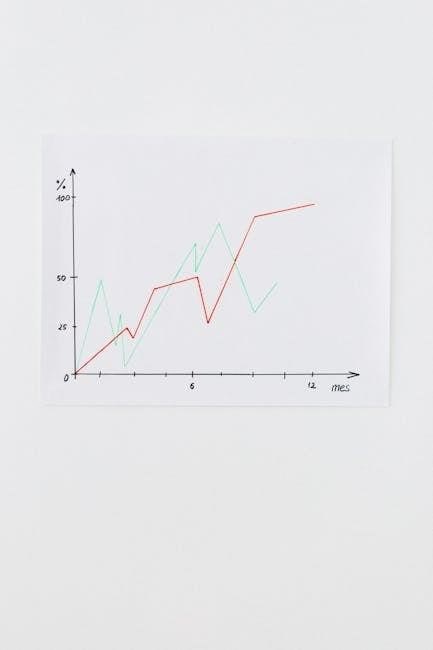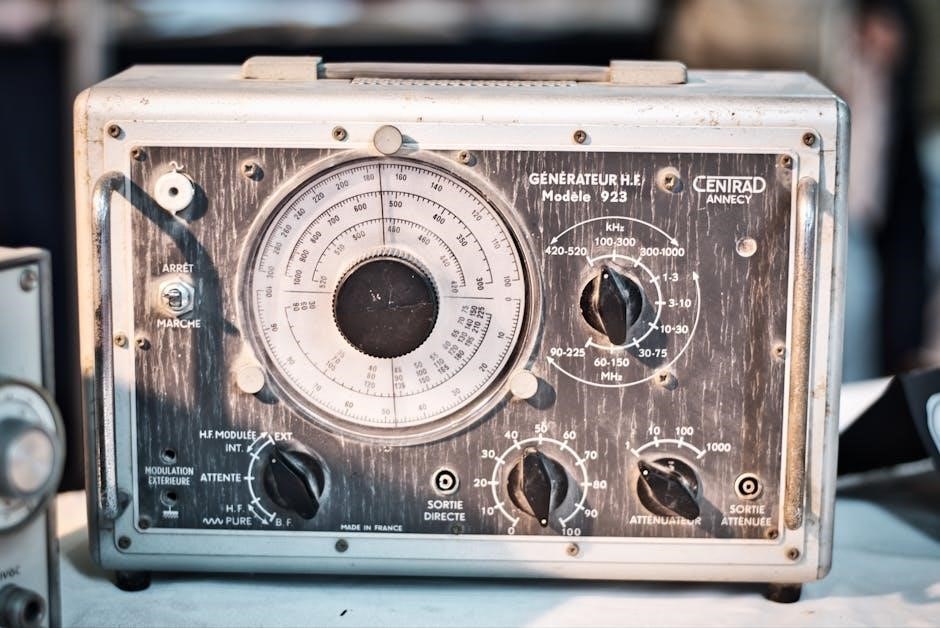The Rate of Perceived Exertion (RPE) Scale is a subjective tool to measure exercise intensity, helping individuals assess how hard they feel they are working. Developed by Gunnar Borg, it provides a personalized way to monitor physical effort, making it essential for tailoring workouts to individual fitness levels.
1.1 Definition and Purpose of the RPE Scale
The Rate of Perceived Exertion (RPE) Scale is a subjective measure used to assess an individual’s effort and physical stress during exercise. Developed by Gunnar Borg, it helps quantify how hard an activity feels, considering factors like muscle fatigue and breathlessness. Its primary purpose is to guide exercise intensity, ensuring workouts are personalized, safe, and effective for individuals of all fitness levels.
1.2 Importance of Subjective Measurement in Exercise
Subjective measurement, like the RPE Scale, is crucial as it allows individuals to personalize their exercise intensity based on personal feelings of exertion. This method is cost-effective, non-technical, and ensures workouts are tailored to individual capabilities, enhancing safety and effectiveness; It bridges the gap between objective metrics and personal experience, making it versatile for diverse fitness levels and populations.

History and Development of the RPE Scale
The RPE Scale was developed by Swedish scientist Gunnar Borg in 1982 as a tool to measure perceived exertion during physical activity, enhancing exercise intensity assessment.
2.1 Gunnar Borg and the Creation of the Scale
Gunnar Borg, a Swedish scientist, developed the RPE Scale in 1982 to measure perceived exertion during physical activity. Borg designed the scale to help individuals assess exercise intensity based on personal feelings of fatigue and breathlessness. The original Borg Scale ranges from 6 to 20, correlating with heart rate, and has become a cornerstone in exercise science for monitoring effort and guiding workouts effectively.
2.2 Evolution of the Scale Over Time
The RPE Scale has evolved since its creation, with adaptations like the 1-10 Borg Scale for simpler use. Originally ranging from 6-20, it now offers variations to suit different populations and needs. Advances in technology have also integrated RPE with wearable devices, enhancing its practicality and accessibility for modern fitness tracking and personalized training programs.
Structure of the RPE Scale
The RPE Scale, developed by Gunnar Borg, typically ranges from 6-20, with each number corresponding to a specific level of exertion, from “no exertion” to “maximal effort.”
3.1 The 6-20 Borg Scale: A Detailed Breakdown
The Borg Scale ranges from 6 to 20, with 6 indicating “no exertion” and 20 representing “maximal effort.” Each number corresponds to a specific exertion level, helping individuals gauge their physical effort accurately. This scale is widely used to monitor exercise intensity, providing a clear and subjective measure of how hard an activity feels, from relaxed to extremely challenging.
3.2 Interpretation of RPE Levels
The RPE Scale levels range from 6 to 20, with 6 indicating “no exertion” and 20 representing “maximal effort.” Each level reflects how an individual feels during exercise, from relaxed (6-8) to moderate effort (9-12), and high intensity (13-16), up to extreme exertion (17-20). This subjective measure helps tailor workouts to personal comfort and physical limits, ensuring safe and effective exercise intensity.
How to Use the RPE Scale
Use the RPE Scale during exercise to rate your exertion levels, adjusting intensity based on your perceived effort. Consider physical sensations like fatigue and breathing to guide your ratings accurately.
4.1 Practical Steps for Applying the Scale
To apply the RPE Scale, start by understanding the 6-20 range, where 6 represents no exertion and 20 is maximal effort. During exercise, rate your perceived exertion by considering muscle fatigue, breathing difficulty, and overall physical stress. Adjust your intensity based on your rating, aiming for a balance between challenge and comfort. Consistency in tracking helps refine your awareness over time.
4.2 Monitoring Exertion Levels During Exercise
During exercise, regularly assess your exertion using the RPE Scale to ensure you’re within your target intensity. Pay attention to physical cues like muscle fatigue, breathing difficulty, and overall discomfort. Adjust your effort based on your RPE rating, aiming to stay consistent with your workout goals. This real-time monitoring helps prevent overexertion and maintains a safe, effective exercise intensity.

Benefits of Using the RPE Scale
The RPE Scale offers a reliable, personalized way to monitor exercise intensity, ensuring workouts are tailored to individual fitness levels while enhancing safety and effectiveness.
5.1 Personalized Exercise Intensity
The RPE Scale allows individuals to tailor their workouts based on personal comfort and exertion levels, ensuring exercises are challenging yet safe. This subjective approach enables personalized intensity adjustments, making it ideal for diverse fitness levels and goals. By focusing on internal sensations, the RPE Scale helps create a balanced and effective exercise routine for each person.
5.2 Non-Technical and Cost-Effective Measurement
The RPE Scale is a simple, non-technical tool requiring no specialized equipment, making it highly accessible and cost-effective. Its reliance on personal perception eliminates the need for expensive gadgets, ensuring anyone can monitor their exercise intensity without financial burden. This practicality makes the RPE Scale a valuable resource for both individuals and fitness professionals worldwide.

Applications of the RPE Scale
The RPE Scale is widely used in fitness training, sports performance, and rehabilitation to monitor and guide exercise intensity, ensuring safe and effective workouts for diverse populations.
6.1 Fitness Training and Sports Performance
The RPE Scale is a valuable tool in fitness training and sports performance, helping athletes and trainers monitor exercise intensity. It allows for personalized workout plans, prevents overtraining, and ensures optimal effort levels. By guiding intensity, it enhances performance and supports goal achievement, making it indispensable for both professionals and recreational exercisers seeking effective and safe training practices.
6.2 Rehabilitation and Clinical Settings
In rehabilitation and clinical settings, the RPE Scale is used to safely monitor exercise intensity for patients. It helps tailor programs to individual capabilities, preventing overexertion and promoting recovery. Clinicians rely on RPE to adjust therapies, ensuring exercises are challenging yet manageable, which is crucial for patients with physical limitations or recovering from injuries, aiding in their gradual and effective rehabilitation journey.

RPE Scale and Exercise Intensity
The RPE Scale effectively measures exercise intensity by assessing an individual’s perceived effort, helping to tailor workouts to personal fitness levels and goals, ensuring safe progression.
7.1 Understanding the Relationship Between RPE and Heart Rate
The RPE Scale correlates with heart rate, as both reflect exercise intensity. While RPE is subjective, heart rate provides an objective measure. Together, they offer a comprehensive view of exertion, helping to balance perceived effort with physiological responses, ensuring workouts are tailored to individual limits and goals for optimal safety and effectiveness.
7.2 Guiding Workout Plans with RPE
The RPE Scale is a valuable tool for creating personalized workout plans by setting intensity levels based on individual perceptions. It helps balance subjective feelings of exertion with physiological responses, ensuring workouts are tailored to fitness levels and goals. This approach allows for adjustments in real-time, optimizing performance while maintaining safety and effectiveness for all individuals.

Common Mistakes When Using the RPE Scale
Common errors include overestimating or underestimating exertion levels, failing to consider individual variability, and not consistently applying the scale during workouts, leading to inaccurate intensity assessments.
8.1 Overestimating or Underestimating Exertion
Overestimating exertion leads to unnecessary strain, while underestimating may result in suboptimal workouts. Both errors stem from inconsistent self-assessment or lack of experience with the scale. Accurate perception requires practice and understanding of physical sensations, ensuring reliable intensity monitoring and effective training outcomes.
8.2 Ignoring Individual Variability
Ignoring individual variability in RPE assessments can lead to ineffective or unsafe workouts. Each person’s fitness level, health conditions, and subjective experience differ, making it crucial to tailor RPE interpretations. Failing to account for personal thresholds may result in overexertion or underperformance, undermining the scale’s purpose of personalized intensity guidance.

Tips for Effective Use of the RPE Scale
Consistency is key when using the RPE Scale. Regularly tracking your exertion levels helps monitor progress and adjust workouts. Combining RPE with heart rate or other metrics enhances accuracy. Always listen to your body and avoid pushing beyond a safe perceived limit to ensure effective and sustainable training.
9.1 Consistency in Rating Exertion
Consistency is crucial when using the RPE Scale. Regularly tracking exertion levels ensures accurate progress monitoring and informed workout adjustments. Trainees should develop a routine for rating effort, using the scale at similar points during exercises. Honest self-assessment and avoiding comparisons with others help maintain reliability. Over time, consistency enhances the effectiveness of RPE-based training programs.
9.2 Combining RPE with Other Metrics
Combining RPE with heart rate, wearable data, or other metrics enhances training accuracy. While RPE provides subjective feedback, objective measures like heart rate offer complementary insights. This integrated approach ensures a balanced view of exertion, helping to optimize performance and reduce injury risks. Using multiple metrics tailors workouts to individual needs, fostering better consistency and overall fitness outcomes.
RPE Scale in Different Populations
The RPE scale is adaptable for various groups, including the elderly, children, and athletes. It helps tailor workouts to individual needs, ensuring safe and effective exercise across diverse populations.
10.1 RPE for Beginners vs. Advanced Athletes
The RPE scale is highly adaptable for both beginners and advanced athletes. Beginners benefit from its simplicity, helping them start at a safe intensity, while advanced athletes can use it to fine-tune their workouts, ensuring they push limits without overexerting. This subjective tool allows for personalized adjustments, making it equally effective for all fitness levels.
10.2 RPE in Special Groups (e.g., Elderly, Children)
The RPE scale is adaptable for special populations, including the elderly and children. For the elderly, it helps monitor exertion without relying on heart rate, which may be influenced by medications. Children can use simplified versions to communicate their effort levels effectively. This tool ensures safe and appropriate exercise intensity for diverse groups, promoting inclusivity and accessibility in fitness routines.

The RPE Scale in Research and Science
The RPE Scale is scientifically validated as a reliable tool for measuring exercise intensity, supported by extensive research and studies confirming its effectiveness in assessing physical exertion levels.
11.1 Validity and Reliability of the Scale
The RPE Scale is a validated and reliable tool for assessing exercise intensity, correlating strongly with physiological measures like heart rate and oxygen consumption. Its consistency across diverse populations and conditions has been repeatedly demonstrated in scientific studies, making it a robust measure for both clinical and fitness settings.
11.2 Studies Supporting the Use of RPE
Extensive research validates the RPE Scale’s effectiveness in measuring exercise intensity. Studies by the American College of Sports Medicine and others confirm its strong correlation with physiological markers like heart rate and oxygen uptake. Gunnar Borg’s original 1982 study and subsequent research demonstrate its reliability across diverse populations, solidifying its role in both clinical and fitness settings.

Digital Tools and RPE
Digital tools, such as mobile apps and software, simplify RPE tracking, enabling users to monitor and record exertion levels efficiently during workouts, integrating with wearable technology for enhanced accuracy.
12.1 Apps and Software for RPE Tracking
Various mobile apps and software now offer RPE tracking features, allowing users to log and monitor their exertion levels during workouts. These tools often include customizable scales, progress tracking, and reminders, making it easier to integrate RPE into fitness routines. They also provide visual graphs to help users understand their exertion trends over time.
12.2 Integrating RPE with Wearable Technology
Wearable technology, such as smartwatches and fitness trackers, can complement the RPE scale by providing real-time physiological data like heart rate and energy expenditure. This integration allows users to cross-reference their subjective RPE ratings with objective metrics, offering a more comprehensive understanding of their exertion levels and helping to optimize workout intensity and recovery.

The RPE Scale in PDF Format
The RPE Scale is widely available in PDF format, offering downloadable guides and templates for easy printing and use. These PDFs often include detailed descriptions and visual aids, making them practical tools for tracking exertion levels during exercise or rehabilitation programs.
13.1 Downloadable Templates and Guides
Downloadable RPE Scale templates and guides are readily available online, offering printable PDF versions for easy use. These resources often include detailed descriptions of each exertion level, visual aids, and instructions for accurate self-assessment. Popular sources like the British Heart Foundation and Clinical Prevention Rehabilitation Ltd. provide these tools, making it simple to integrate the RPE Scale into fitness routines or clinical settings.
13.2 How to Create a Custom RPE Scale PDF
To create a custom RPE Scale PDF, use design tools like Canva or Adobe Illustrator. Start with a template, then add your brand or specific instructions. Include the scale, descriptions, and visual cues. Save as a PDF and share easily. This allows for personalized versions tailored to individual or organizational needs, ensuring clarity and professional presentation.
Case Studies and Examples
Real-life applications of the RPE Scale include training programs for athletes and rehabilitation plans. Success stories highlight improved performance and recovery, showcasing its practical effectiveness in various settings.
14.1 Real-Life Applications of the RPE Scale
The RPE Scale is widely used in fitness training, sports performance, and rehabilitation. It helps athletes optimize their workouts and ensures patients in clinical settings exercise safely; Coaches and trainers rely on it to guide intensity levels, while individuals use it to personalize their routines, making it a versatile tool for diverse fitness goals and recovery programs.
14.2 Success Stories from Athletes and Trainers
Athletes and trainers have reported significant benefits from using the RPE Scale. It helps prevent overtraining by guiding intensity levels, ensuring optimal performance. Many athletes credit the scale for enhancing their endurance and strength, while trainers appreciate its ability to tailor workouts to individual needs, leading to better overall results and faster recovery times.
Frequently Asked Questions (FAQs)
What is the RPE Scale? It is a subjective tool to measure exercise intensity, helping individuals assess how hard they feel they are working during physical activity.
Is the RPE Scale reliable? Yes, it is widely used and reliable for guiding exercise intensity, as it reflects individual perceptions of effort and fatigue.
15.1 Common Queries About the RPE Scale
Common questions about the RPE Scale include its definition, purpose, and reliability. Many ask how to accurately rate exertion levels and interpret the scale. Others inquire about its application in different fitness levels and populations, such as beginners or special groups. Additionally, questions arise about its comparison with heart rate monitoring and its effectiveness in guiding workout intensity.
15.2 Addressing Misconceptions
Some believe the RPE Scale is unreliable due to its subjective nature, but research confirms its validity. Others think it’s only for athletes, yet it’s versatile for all fitness levels. Misconceptions also include its complexity, but the scale is simple and user-friendly. Additionally, it’s often thought to compete with heart rate monitoring, when in fact, they complement each other for comprehensive workout tracking.
The RPE Scale remains a cornerstone in fitness and clinical settings, offering a reliable, subjective measure of exertion. Future advancements may integrate technology for enhanced accuracy and accessibility.
16.1 The Role of RPE in Modern Fitness
The RPE Scale plays a vital role in modern fitness by providing a reliable, subjective measure of exercise intensity. It allows individuals to tailor workouts to their personal limits, ensuring sessions are challenging yet safe. Its simplicity and cost-effectiveness make it a versatile tool for gyms, sports, and rehabilitation, bridging the gap between subjective perception and objective performance metrics.
16.2 Potential Advances in RPE Measurement
Future advancements in RPE measurement may include integration with wearable technology and AI for real-time feedback. Combining RPE with heart rate and other metrics could enhance accuracy. Digital tools and apps could simplify tracking, while gamification might improve user engagement. Expanding RPE applications to diverse populations and refining its scalability for clinical use are also promising areas for development.